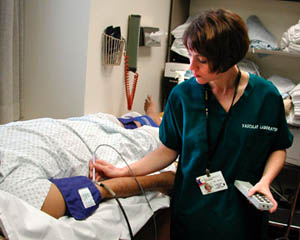A pulse volume recording, or PVR test, measures blood pressure and blood flow in your legs. It’s a quick, noninvasive test that can diagnose or monitor peripheral artery disease (PAD). A PVR test can also help identify areas of the leg where there may be a partially blocked artery.
Advertisement
Cleveland Clinic is a non-profit academic medical center. Advertising on our site helps support our mission. We do not endorse non-Cleveland Clinic products or services. Policy

A pulse volume recording, or a PVR test, measures blood flow in your legs. It uses ultrasound (high-frequency sound waves) to evaluate circulation in your arteries. A PVR test is painless and noninvasive, so it doesn’t require any needles or cuts in your skin. It’s also called pulse volume plethysmography or a segmental pressure test.
Advertisement
Cleveland Clinic is a non-profit academic medical center. Advertising on our site helps support our mission. We do not endorse non-Cleveland Clinic products or services. Policy
Your healthcare provider may recommend a pulse volume recording to diagnose or assess peripheral artery disease (PAD). PAD develops when the blood vessels carrying blood from your heart to your legs get too narrow. It’s usually the result of atherosclerosis (build-up of cholesterol and plaque in your arteries).
PVR tests can help locate blood clots or other blockages in your legs. If you have unexplained leg pain when walking, your healthcare provider may order a PVR test to check for blockages.
Sometimes a PVR can also help diagnose:
A pulse volume recording is one type of noninvasive vascular test. Your healthcare provider may recommend a PVR test in combination with:
Advertisement
Healthcare providers called vascular technologists or sonographers usually perform PVR tests and other noninvasive vascular testing. Sometimes a nurse performs your PVR test.
You don’t need to do anything special to prepare for a PVR test. Your healthcare provider may ask you to stop taking certain medications or avoid smoking before the test.
You remove your clothes and jewelry and change into a hospital gown before your PVR test. You won’t need any anesthesia or sedation because the test is painless and noninvasive. A PVR test typically takes between 30 and 60 minutes.
Be sure to let the technician know if you have had any previous treatments for vascular diseases, such as a stent, angioplasty or bypass procedure.
During a pulse volume recording:
You can go home after your PVR test and resume normal activities.
A PVR test is a safe, noninvasive procedure that doesn’t carry any serious risks.
The vascular technician or sonographer works with a physician to evaluate and interpret the results. This may take anywhere from a few hours to a few days. Ask your healthcare provider when you can expect your results.
Your healthcare provider compares the blood pressure in your legs to the blood pressure in your arms. If the blood pressure is lower in your legs than in your arms, you may have arterial disease. Your provider also compares the pulse among parts of your leg to identify the general location of blockages or narrowed arteries. A PVR test does not indicate which specific arteries are affected.
You may want to ask your healthcare provider these additional questions if your PVR test results are abnormal:
A pulse volume recording, or PVR test, is a noninvasive vascular test that measures blood pressure and the rate of blood flow in the arteries of your legs. It’s a common test to diagnose or assess peripheral artery disease (PAD). The results of a PVR test can help your healthcare provider plan additional testing or treatment.
Advertisement
Vascular disease may affect your life in big and small ways. Cleveland Clinic’s specialists treat the many types of vascular disease so you can focus on living.

Last reviewed on 07/22/2022.
Learn more about the Health Library and our editorial process.